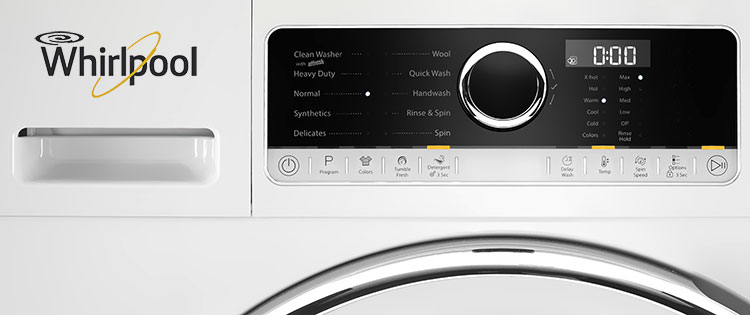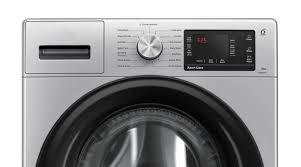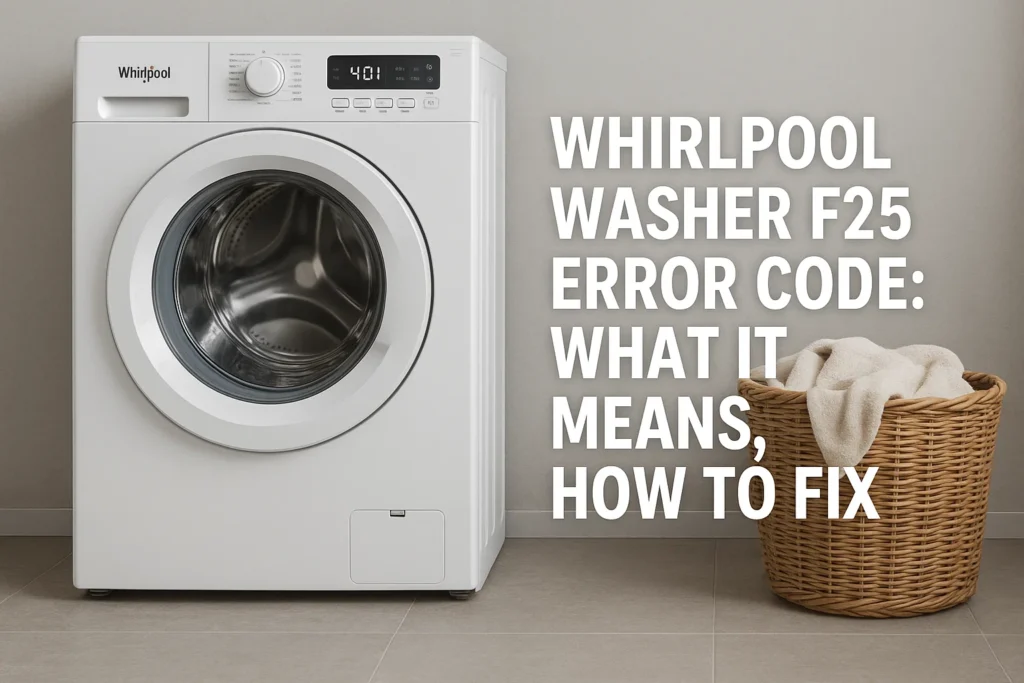Seeing a cryptic F25 flash during laundry day is stressful—your washer stops, the drum won’t ramp up, and you’re left wondering if it’s a cheap sensor or a spendy board. This guide explains what F25 means, the usual causes, what you can safely check yourself, when to call a pro, and how to prevent a repeat. The F25 error code is a relatively known Whirlpool issue that many owners bump into sooner or later.
What Does the F25 Error Code Mean?
Official/typical meaning: F25 indicates a drive-motor tachometer (speed) detection fault—the control isn’t reading motor RPM correctly. In plain English, the washer can’t verify how fast the motor is spinning, so it aborts the cycle.
How the electronics interpret it: The main control (and/or the motor control unit, MCU) expects pulses from the tachometer as the motor spins. If those pulses are missing, unstable, or out of range, the control throws F25 and halts.
When it often appears: Most commonly as the washer tries to accelerate into spin—sometimes right after the drain—because that’s when RPM feedback becomes critical.
Common Causes (Why F25 Happens)
- Faulty tachometer (motor speed) sensor. If the tacho coil or its magnet fails, RPM feedback drops out and F25 appears.
- Wiring or connector issues between the motor/tachometer, the MCU, and the main board (loose plug, corrosion, broken harness).
- Defective drive motor (worn bearings, internal shorts, or mechanical drag) that prevents stable speed.
- Faulty motor control unit (MCU) or main control board—bad components or burnt traces can corrupt speed processing.
- Overload or mechanical obstruction (items wedged between tubs, drain problems) increasing drag so RPM never reaches target.
- Temporary glitch or misread that clears after a power reset.

DIY Diagnosis (Safe Checks You Can Do)
Safety first: Unplug the washer. Shut water valves if you’ll move the machine.
- Power-cycle reset (5–10 min). Unplug, wait, plug back in; sometimes the control recovers if the issue was transient.
- Inspect harnesses & connectors. Reseat motor, tachometer, and MCU plugs; look for bent pins, looseness, oxidation, or chafed wires.
- Access motor/tachometer. Remove the rear or bottom panel (model-dependent) to reach the drive motor and its tachometer puck.
- Test the tachometer (if you’re comfortable). With a multimeter, measure resistance/continuity across the tacho leads; an open or short indicates failure.
- Spin test. Turn the drum by hand; feel for roughness or binding that points to motor/bearing drag.
- Visual MCU check. Look for scorch marks, swollen components, or a burnt smell on the motor control board.
- Check for obstructions/drain issues. Verify the pump filter/hoses and that nothing is jammed between inner and outer tubs.
Mid-article resource if you’d rather not DIY further: book Whirlpool washer service in NYC.
Possible Fixes
- Replace a failed tachometer sensor.
- Repair or re-secure wiring/connectors (clean corrosion, replace damaged harness).
- Replace/repair the drive motor if mechanically rough or electrically compromised.
- Replace the MCU or main control when board damage or diagnostics confirm failure.
- Remove obstructions & ensure free spinning.
- After any repair, reset and run a test spin to confirm RPM feedback is stable.
(Parts and steps depend on your model; always follow its tech sheet.)
When to Call a Professional
- You’re not comfortable opening the cabinet or testing electronics.
- F25 returns after resets and connector checks.
- Suspected motor or control-board failure—costly parts, delicate diagnosis.
- You need model-specific procedures or have warranty coverage.
NYC readers can get same-day help here: local Whirlpool washer repair experts.

Preventive Tips
- Don’t overload—heavy loads stress the motor and control feedback.
- Keep loads balanced to avoid violent ramp-ups.
- Periodically clean the pump filter/hoses; remove coins, pins, and debris.
- Avoid repeated high-strain cycles if the machine is struggling.
- Once a year, quickly inspect wiring at the motor/MCU for rub points.
FAQ
Can I clear F25 by unplugging?
Sometimes; a 5–10 minute power reset can clear a false trip, but recurring F25 means there’s a real fault.
Will replacing the motor always fix F25?
No. Many F25 cases are tachometer or wiring related, and some are MCU/main-control failures. Diagnose first.
Does F25 occur in all Whirlpool models?
It’s common across several Whirlpool/“Duet”-style front-loaders that use an MCU + tacho feedback, but behavior and access steps vary by model.
How much do a tachometer or motor board cost?
Prices vary widely by model; the MCU typically costs more than a tacho or harness.
Is it safe to run the washer with F25 occasionally?
Not recommended. The machine can’t verify speed, so continued use risks further damage or abrupt stops mid-cycle.

| Symptom | Likely Cause | DIY First Steps | When to Call a Pro |
|---|---|---|---|
| F25 right as spin starts | Tachometer misread / wiring | Unplug 10 min; reseat motor & MCU connectors | If F25 returns after reset and reseat |
| Grinding or heavy drag | Motor/bearing drag; item stuck | Spin drum by hand; check pump filter & tub gap | If drag persists or obstruction not accessible |
| Visible board damage | MCU/main-board fault | Disconnect power; do not run | Board testing/replacement required |
Conclusion
F25 means the control isn’t getting trustworthy motor-speed feedback—usually due to the tachometer, wiring, motor drag, or the control board itself. Work methodically: reset, reseat, inspect, test, then replace only what diagnostics identify. And if you’d rather skip the headache, you can schedule a Whirlpool washer repair in NYC here: trusted washer technicians near you.
